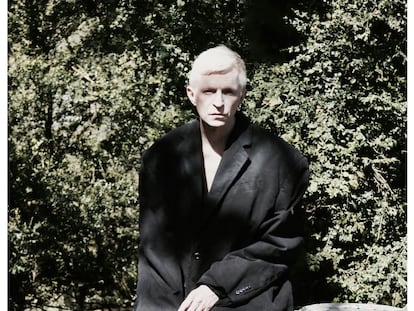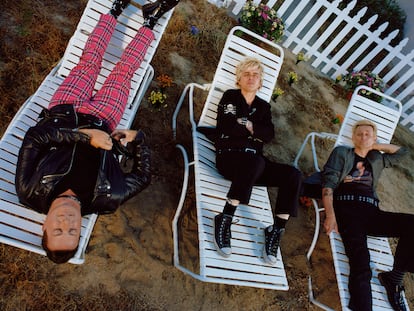Hardcore Beethoven: electronic music revives classical masterpieces
Young DJs remixing Mozart, Vivaldi, Bach and Beethoven are conquering social media and packing concert venues

In a parallel universe, Wolfgang Amadeus Mozart joins a rave and breaks down the beat of Antonio Vivaldi’s Winter to the delight of an ecstatic audience. This alternate world has been flourishing for over a year on social media, and now is sweeping through concert venues in many European capitals. DJs reinterpret classical masterpieces and share their creations online, captivating the younger generation and sparking a cultural phenomenon. Now you can also experience a hardcore electronic remix of Ludwig van Beethoven at music festivals.
In August 2023, a TikTok video created by the mostly unknown DJ BENNETT went viral. A remix of the popular Vois sur ton chemin (Look to your Path, in English) song from the 2004 film Les Choristes (The Choirboys, in English) , became wildly popular with millions of views worldwide. The track has now been streamed over 210 million times on Spotify. BENNETT’s remix has around 11 million monthly listeners on Spotify, and he now collaborates with producers like David Guetta.
The French feature film’s soundtrack by Bruno Coulais might not fit the strict definition of classical music, and BENNETT’s remix could be considered a rather basic sampling. But the remix sparked the imaginations of many youths making their own electronic music at home. BUNT and VisionV sampled Brahms’ Hungarian dances in their Renaissance composition. Reductio remixed Mozart’s Symphony No. 40 in G minor, and the G&J duet sampled Tchaikovsky’s Swan Lake, among other classics.
Leblanc, a 25-year-old DJ from Paris, credits his mother for his love of music. He discovered electronic music playing video games as a teenager. “I absolutely loved it! It was so new to me that I thought, ‘Why not give it a try?’ I installed a program, watched tutorials online, and I’ve been making music ever since.” His compositions include a remix of Lacrimosa from Mozart’s Requiem and Palladio by Karl Jenkins that have chalked up hundreds of thousands of streams. “I’ve always loved classical music – it’s the kind of music that gives me goosebumps.”
“I started mixing electronic and classical because some folks think classical music is boring. But hey, it’s not! I wanted to breathe new life into it, give it a second birth,” said Leblanc. He began just over a year ago and has already gained over 220,000 monthly Spotify listeners who are drawn to the blend of two seemingly distant genres. “All modern styles take a cue from classical music in some form. It’s the foundation of everything we have today. From pop tunes to rap beats, the roots of classical music can be found in all kinds of music.”
The classical-electronic fusion emerged and flourished on social media, particularly on TikTok. “I knew that there was a niche for this kind of music. Apashe combines “bass” electronica with classical pieces, while Worakls adds a “deep house” vibe. They’ve inspired a lot of people, including myself,” said Leblanc. “My work got so much love, and I’m totally thrilled about it!” In November, Leblanc joined the Joystick talent agency, and says he’s not opposed to using platforms to profit from his compositions. “That’s what I did with Una Mattina by Ludovico Einaudi. When I remix, I always aim to create something that I will enjoy listening to. But I also have to keep in mind that people should be able to recognize the track. That way they’ll keep coming back to my TikTok.” Leblanc thinks young people identify with his compositions because of nostalgia. It’s a longing for the good old days, memories of The Choir Boys or the Vienna Philharmonic’s New Year’s Concert. It’s the same feeling that comes from hearing an old jingle from a commercial.
The classical-electronic creative process is very similar for many composers. Most use sampling – a fragment from another composition that is inserted into a new one. Then a pounding rhythm called a drop is added. The result is part classical and part electronic. Leblanc likes to carefully craft his compositions. “The first thing I consider is the BPM – beats per minute. It’s basically the music tempo. electronic usually falls between 120 and 130 BPM, so I look for a classical piece around that tempo to blend in without messing up the vibe,” he said. “I basically re-instrument everything. I don’t just stick to using a sample. I take all the midi, all the notes, all the cellos, violas, violins and then I recompose everything to give me more flexibility when I’m working. I enjoy mixing it all the way through, from start to finish.”
Sampling is nothing new. It’s trendy to use it with classical music, but reworking existing pieces is a longstanding tradition in music. Javier Blánquez is a journalist, music history professor and author who has written two books on the history of electronic music. “Clearly, there’s a connection between the two genres,” said Blánquez. “But it’s all about sampling and remixing, which has been big since the 1980s and really took off in the 1990s. It’s a long-standing trend that’s here to stay. But sampling classical music isn’t any harder than doing it with disco or jazz.”
Like Leblanc, Blánquez noted that some compositions are much more carefully crafted than others. “The more basic compositions are seen a lot in hip hop. Many producers made hits by directly sampling a popular song without adding much originality or creativity,” said Blánquez, who pointed to I’ll Be Missing You by Sean Combs (Puff Daddy, Diddy) as an example. The song pays tribute to the late rapper Notorious B.I.G. and includes a sample from a song by The Police.
The 1990s saw a trend blending dance and ethnic music, adding an exotic touch. This fusion included music from Africa, Oceania and the Maghreb region. “All these connections have been kept up over time. They’re not pure branches of music evolution, but they have their place,” said Blánquez. He cites Yeke Yeke, a huge ethnic-electronic hit by Guinean singer Mory Kanté that topped the charts in Belgium, Finland, Spain and the Netherlands in 1987.
@martino_prinzivalli @Indira Paganotto transform a classic masterpiece of Paganini in a techno beast beat. Whatch till the end 🔥🖤. . #techtok #techno #indirapaganotto #classicalmusic #paganini #caprice #rave #concert #crazy #dj #hardcore #dream
♬ suono originale - Martino Prinzivalli
The classical-electronic fusion gaining popularity in Europe (which hasn’t enjoyed the same success in the U.S.) could be classified under the techno subgenre of electronic music. Blánquez compares it to electronic dance music – EDM – which encompasses dance-oriented subgenres like techno, trance and house music. “EDM really hit its peak at the start of this century. It kind of dipped after that, but it’s still around and has produced all sorts of subgenres that capture niche audiences.” For example, melodic techno emerged in 2018 and become a top electronic sound globally. Emphasizing melody with emotion and darkness, it is viewed by some as the precursor to the current classical music sampling craze.
Leblanc plans to release a new album in the spring that will include four songs with classical-electronic fusions. “Right now, I’m sticking to this path, but further on, I plan to release some of my own compositions. It’s cool to put my spin on classical music, but I also want people to see that I can create my own stuff, not just remix tracks from others.” He also hope his music will foster a greater appreciation for classical music among young audiences.
“This trend will be beneficial if it sparks genuine interest in classical music, because listening to classical music is a powerful form of resistance in a world where everything, especially music, is designed for fast consumption,” said Blánquez. “Appreciating classical music demands focus and commitment. In an era of short attention spans, this trend could introduce classical music in a way that shows it’s not as daunting as they once believed. It may encourage young people to explore further, and has the potential to be truly helpful.”
Sign up for our weekly newsletter to get more English-language news coverage from EL PAÍS USA Edition
Tu suscripción se está usando en otro dispositivo
¿Quieres añadir otro usuario a tu suscripción?
Si continúas leyendo en este dispositivo, no se podrá leer en el otro.
FlechaTu suscripción se está usando en otro dispositivo y solo puedes acceder a EL PAÍS desde un dispositivo a la vez.
Si quieres compartir tu cuenta, cambia tu suscripción a la modalidad Premium, así podrás añadir otro usuario. Cada uno accederá con su propia cuenta de email, lo que os permitirá personalizar vuestra experiencia en EL PAÍS.
¿Tienes una suscripción de empresa? Accede aquí para contratar más cuentas.
En el caso de no saber quién está usando tu cuenta, te recomendamos cambiar tu contraseña aquí.
Si decides continuar compartiendo tu cuenta, este mensaje se mostrará en tu dispositivo y en el de la otra persona que está usando tu cuenta de forma indefinida, afectando a tu experiencia de lectura. Puedes consultar aquí los términos y condiciones de la suscripción digital.
More information
Archived In
Últimas noticias
Half of Scotland is in the hands of 420 property owners
Pinochet’s victims grapple with José Antonio Kast’s rise in Chile
Reinhard Genzel, Nobel laureate in physics: ‘One-minute videos will never give you the truth’
From digital curfews to blocking apps: How technology experts protect their children online
Most viewed
- Pablo Escobar’s hippos: A serious environmental problem, 40 years on
- Reinhard Genzel, Nobel laureate in physics: ‘One-minute videos will never give you the truth’
- Why we lost the habit of sleeping in two segments and how that changed our sense of time
- Charles Dubouloz, mountaineering star, retires at 36 with a farewell tour inspired by Walter Bonatti
- The Florida Keys tourist paradise is besieged by immigration agents: ‘We’ve never seen anything like this’











































